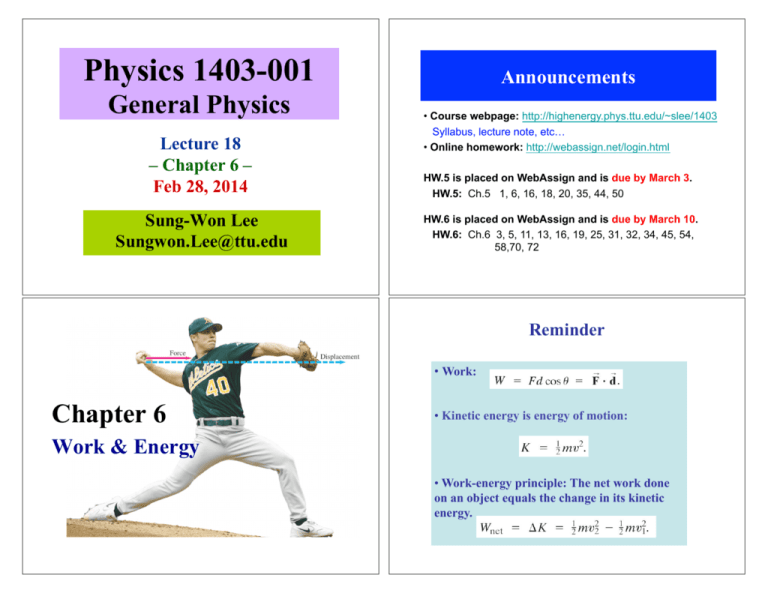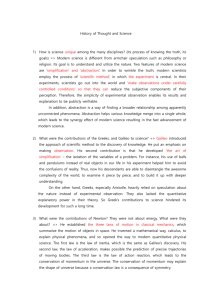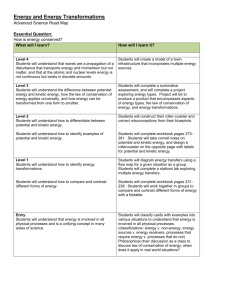Document
advertisement

Physics 1403-001 General Physics Lecture 18 – Chapter 6 – Feb 28, 2014 Sung-Won Lee Sungwon.Lee@ttu.edu Announcements • Course webpage: http://highenergy.phys.ttu.edu/~slee/1403 Syllabus, lecture note, etc… • Online homework: http://webassign.net/login.html HW.5 is placed on WebAssign and is due by March 3. HW.5: Ch.5 1, 6, 16, 18, 20, 35, 44, 50 HW.6 is placed on WebAssign and is due by March 10. HW.6: Ch.6 3, 5, 11, 13, 16, 19, 25, 31, 32, 34, 45, 54, 58,70, 72 Reminder • Work: Chapter 6 • Kinetic energy is energy of motion: Work & Energy • Work-energy principle: The net work done on an object equals the change in its kinetic energy. Potential Energy, final Mechanical Energy • Relation between work and potential energy • ΔPE = PEf – PEi = - W • The sum of the potential and kinetic energies is called the mechanical energy • The potential energy of an object when it is at a height h is PE = mgh • Conservation of Mechanical Energy • KEi + PEi = KEf + PEf • A very powerful tool for understanding, analyzing, • Potential energy is stored energy • It can be converted to kinetic energy and predicting motion (we will see this today) Section 6.3 Conservation of Mechanical Energy • Look at work done by the book as it falls from some height to a lower height • From work-kinetic energy theorem, Won book = ΔKbook • Also, W = FΔr = mg(yb)– mg(ya ) = ΔKbook • mgyb – mgya = (Ui - Uf) = -(Uf- Ui) = -ΔUg Section 6.3 Charting the Energy • A convenient way of illustrating conservation of energy is with a bar chart • The sum of the energies is the same at the start and end • So, ΔK = -ΔUg => ΔK + ΔUg = 0 " • We define the sum of kinetic and potential energies as mechanical energy in the system: Emech = K + Ug • The statement of Conservation of Mechanical Energy for an isolated system: Kf + Uf = Ki+ Ui Section 6.3 Problem Solving Using Conservation of Mechanical Energy In the image on the left, the total mechanical energy at any point is: Problem Solving Using Conservation of Mechanical Energy If the original height of the rock is y1 = h = 3.0 m, calculate the rock s speed when it has fallen to 1.0 m above the ground. The rock s potential energy changes to kinetic energy as it falls. Note: bar graphs representing potential energy U and kinetic energy K for the three different positions. Problem Solving Using Conservation of Mechanical Energy Assuming the height of the hill is 40 m, and the roller-coaster car starts from rest at the top, calculate (a) the speed of the roller-coaster car at the bottom of the hill 1 1 mv12 + mgy1 = mv22 + mgy2 2 2 8-4 Problem Solving Using Conservation of Mechanical Energy Assuming the height of the hill is 40 m, and the roller-coaster car starts from rest at the top, calculate (b) at what height it will have half this speed. Take y = 0 at the bottom of the hill. Solving Using Conservation of Mechanical Energy Estimate the kinetic energy and the speed required for a 70-kg pole vaulter to just pass over a bar 5.0 m high. Assume the vaulter s center of mass is initially 0.90 m off the ground and reaches its maximum height at the level of the bar itself. 1 1 mv12 + mgy1 = mv22 + mgy2 2 2 A re-look at some problems Let s say that we want to know the velocity of a block sliding on a frictionless inclined plane after it has slid down from a height h. h We determined the acceleration down the plane before using F = ma s θ! (m)adown plane = (m)g sinθ 2 v2 = v2 + 2 a s = v + 2 g sinθ (h / sinθ) 0 0 v2 = v2 + 2 g h 0 v = √2 g h if it starts from rest (i.e v0=0) Using Energy Conservation Let s say that we want to know the velocity of a block sliding on a frictionless inclined plane after it has slid down from a height h. h s θ! Using Energy Conservation Let s say that we want to know the velocity of a block sliding on a frictionless inclined plane after it has slid down from a height h. Kf + Uf = Ki + Ui h s θ! Kf + Uf = Ki + Ui 2 1 – mv 2 f 2 +0= 1 – 2 mv2 + mgh 2 i vf = vi + 2 g h if it starts from rest vf = √2 g h A Swinging Pendulum Now what about a block sliding down an incline like this Here the acceleration down the plane is continually changing since the angle of plane with the horizontal changes. h Kf + Uf = Ki + Ui 2 1 – mv f 2 2 2 + 0 =1– mvi + mgh 2 2 vf = vi + 2 g h if it starts from rest vf = √2 g h Total Energy is same everywhere. Top of swing: v=0, K=0 (A,C) all U v = √2 g h Bottom of swing: U=0 (B) max v, All K starts from rest at height h solve for velocity at bottom of swing h Kf + Uf = Ki + Ui 2 1 – mv f 2 + 0 =1– mv2 + mgh v2f = v2i + 2 g h 2 i v f= √2 g h









